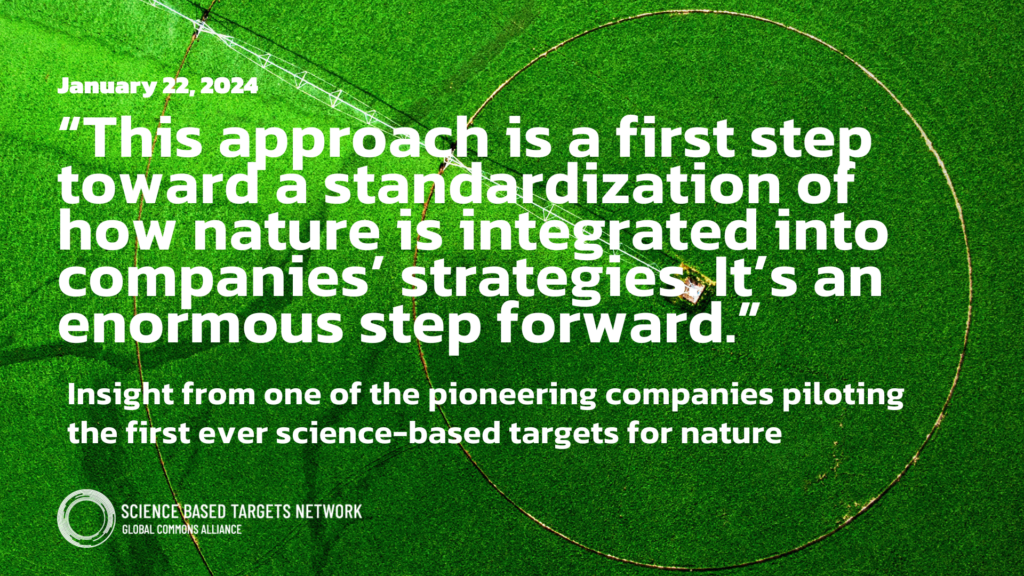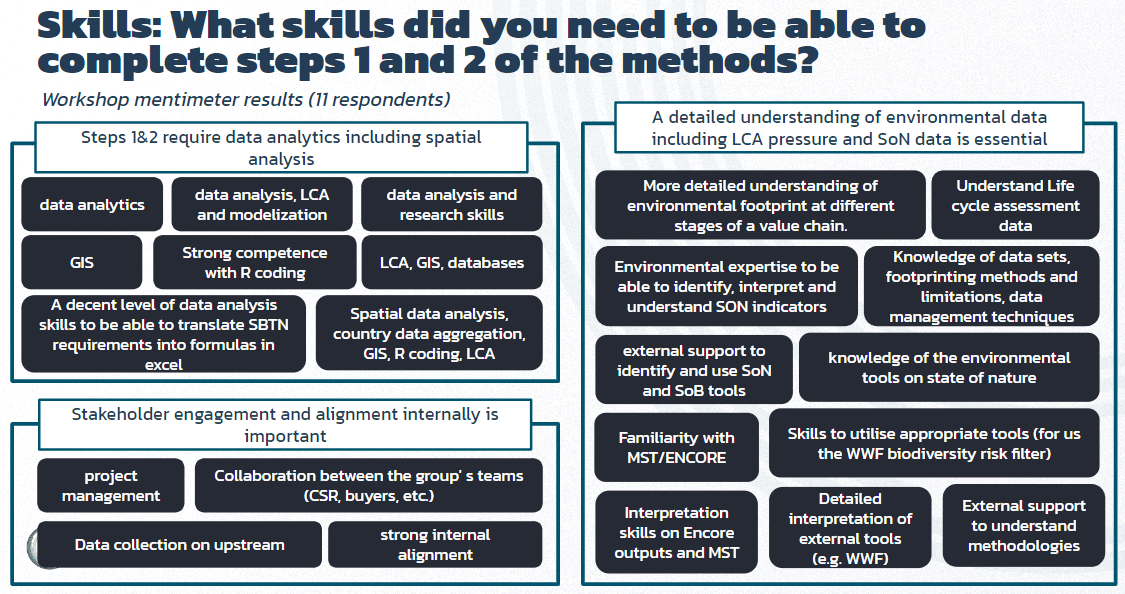
Unlocking insights and changing mindsets: what it is like to pioneer science-based targets for nature
Company:
Pilot companies
In May 2023, 17 pioneering companies representing sectors and supply chains significantly impacting nature embarked upon a unique journey: piloting the first-ever science-based targets for nature.
Central to the pilot is determining the optimal balance between rigor and feasibility, ahead of opening the target validation process up more broadly to companies later this year. Up to this point, the pilot companies have contributed a wealth of data, totaling over 20,000 data points.
As we navigate through the final stages of this pilot which concludes in May 2024 – resulting in the first validated targets – we will share a comprehensive report.
In the meantime, we are pleased to highlight some initial top line insights into what it’s like to pioneer science-based targets for nature. These were gathered during the pilot through a combination of workshops, interviews and anonymized surveys.
Alongside this official pilot, there are approximately 160 companies preparing to set science-based targets for nature in some form; including 125 from SBTN’s Corporate Engagement Program plus companies working through partners including SBTN’s referral program.
Below are five insights from pilot companies about what it’s like to pioneer science-based targets for nature.
INSIGHT #1
Opportunities beyond risk management
Pilot companies value science-based targets for nature as a risk management tool to increase resilience, but also see opportunities beyond this.
As articulated by one pilot company:
“These methods provide value in the form of risk mitigation – identifying risk along the supply chain – as well as improved reputation, and competitive advantage.”
The pilot companies are recognizing that the targets can be a catalyst for change:
“This approach is a first step towards a standardization of how nature is integrated into companies’ strategies. It’s an enormous step forward.”
GSK shared its perspective, revealing that the scientific approach that SBTN brings has deepened their understanding of the organization’s impacts and dependencies on nature, and helped to refine and prioritize the action they are taking to meet their existing nature targets — a testament to the “immense value of the framework”.
Moreover, pilot companies appreciate the interoperability of SBTN with other related sustainability initiatives.
As Bel advised:
“By doing SBTN you are paving the way for other frameworks – at least from a data perspective, the process is extremely rigorous and science-based. Climate and nature are deeply interrelated; SBTN gives us a clear pathway to create a resilient food model.”
Alpro highlighted the uniqueness of SBTN’s framework to assess nature’s materiality, emphasizing its alignment with the TNFD, and its establishment as a standard for action on nature:
“This is striking a chord with leadership, and we are seeing the business value of setting targets in this pilot.”
INSIGHT #2
Validating and raising ambition
Companies acknowledge the pilot’s impact on their nature ambitions. As Kering emphasized:
“If you’re not talking about systemic transformation or collaborative transformation, it’s very hard for you to raise your own ambition as well. We think there’s so much promise and huge value [in these methods]”.
The methods are encouraging companies to expand their scope of measuring their environmental impacts from solely direct operations to include upstream. As Holcim highlighted, they are establishing the first-of-its-kind targets for upstream activities.
GSK noted a significant transformation driven by the process of setting science-based targets for nature, which is engaging with suppliers to increase traceability and data transparency on where and how materials are sourced – which are “often well beyond the suppliers we procure directly from”.
Another pilot company reported the methods are not only helping them increase their sustainability ambitions but also validate current ones. In addition, the newfound understanding of this organization’s impacts and dependencies on nature is helping change mindsets internally regarding the urgency of taking action.
Companies are also evaluating a wider range of environmental impacts:
“Piloting science-based targets for nature has helped us identify areas where we can strengthen our existing climate focused initiatives, such as our forest positive and regenerative agriculture programs, to better respond to nature-related risks and opportunities across our value chain”. Conor McMahon, Global Net Zero and Nature Lead at Nestle
Critically, this integrated assessment of nature impacts alongside climate has led some companies to identify raw materials that, despite minimal GHG emissions, exert significant impacts on nature.
INSIGHT #3
Measurable benefits
The process of assessing and prioritizing value chain impacts on nature (Steps 1 & 2 of the methods) requires companies to increase their upstream traceability and work more closely with suppliers to understand their impacts. Consequently, this process has led companies to uncover hidden risk within the supply chain, prompting them to prioritize action in locations where it really matters. As one company attested, “after getting the Steps 1 & 2 results, we took quick actions to mitigate risk for some sourcing locations”.
While the first freshwater quality targets focus on nutrient pollution, the target-setting process requires a comprehensive assessment of collecting water pollution data.
During this process, one company discovered an issue with the use of herbicides within a specific basin, adversely impacting water quality. As the scope of freshwater quality targets expand in the future, the company will be able to set a science-based target to address this issue. In the meantime they are taking steps to collaborate with suppliers to mitigate this negative impact.
In addition to risk mitigation, several companies have also experienced a cascading effect in engagement and collaboration, both internally and throughout the supply chain. This has included capacity building initiatives with suppliers to gather more granular data.
One company shared that engagement with local water authorities required capacity building to educate them about the concept of the freshwater targets. This collaboration evolved into a mutually beneficial partnership, as local water authorities have the knowledge and expertise to help the company set its targets.
Furthermore, setting science-based targets for nature has generated tangible quantitative business outcomes for some. For instance, Hindustan Zinc is strategically planning to achieve cost savings through enhanced water use efficiency, and one pilot company advised that having credible nature targets is leading to easier access to credit and financing.

INSIGHT #4
Balancing rigor and feasibility
By definition SBTN’s methods are ambitious and challenging, aligning with the direction of travel all companies need to pursue to halt and reverse nature loss. Notably governments (see latest EU regulations on deforestation for example) are pushing for ambitious upstream value chain assessments, including of high impact commodities.
Similarly investors, as evidenced by TNFD and CDP, are increasingly expecting companies to take such ambitious measures. As observed by Holcim:
“Investors are asking for this. The extended stakeholders are waiting for it.”
The methods aim to find the equilibrium between what is currently feasible for companies and what will elevate the level of ambition of action for nature. Striking this balance remains an ongoing challenge that requires continual optimization.
One illustration of this challenge, highlighted by the pilot, lies in the necessary place-based emphasis of science-based targets for nature, and therefore the need for upstream traceability. Companies face obvious challenges to get full visibility, with data collection and data quality presenting notable hurdles.
We recognize that the landscape for data and tools to address nature loss is less mature than that for climate. To address this, we are proactively collaborating with developers to identify relevant tools and data, and also creating additional guidance to help companies build traceability in their supply chains. Simultaneously we can ensure companies are taking action through target setting in parts of their supply chain with greater traceability.
The tension between scientific rigor and practical application extends to sector-specific considerations. Our value chain assessment methodologies are intentionally designed to be cross-sector to allow for broad corporate engagement, and as highlighted by a pilot company, “we appreciate that SBTN at least tries to enable all the sectors to set targets.” However some companies expressed a need for methods to be more flexible and tailored to their particular industry realities. As one pilot company remarked, “some things are not feasible for our sector.“
To further facilitate implementation, we are looking to enhance existing methods by providing sector-specific on-ramps at critical parts of the methodologies. Additionally we aim to provide sector-specific validation guidance, and are working closely with industry coalitions to ensure applicability and ease implementation.
It should be noted that our first targets related to water quality for nitrogen and phosphorus, land footprint reduction, and no conversion for natural lands targets have more focused applicability within high-impact forest, land and agriculture sectors (FLAG) and also those sectors that source from FLAG such as fashion and retail.
INSIGHT #5
People at the core: Skills, expertise and collaboration
The key to successful implementation hinges not just in the methodologies, but in the people who bring them to life. Our survey responses from pilot companies highlight this (see image below). Skills such as expertise in lifecycle assessment and footprinting, proficiency in spatial analysis, and deep understanding of environmental data are crucial. These can be built within a company or alongside the assistance of a consultant (view our list of expert advisors).

But it’s not just about technical know-how. Equally important is the internal buy-in and support required to ensure the successful collection of data. Effective coordination, for example, with procurement departments on upstream data is essential. This is particularly true for large companies sitting downstream of the value chain, where the exercise of preparing and collecting data represents a significant undertaking, necessitating adequate resources and effective project management.
In recognition of this, we are preparing additional resources to support companies through the onboarding journey. A key resource is our forthcoming Corporate Manual, designed as a practical introductory guide to SBTN’s methods, distilling hundreds of pages of technical guidance.
We are also introducing a self assessment tool to support companies in their preparations preceding the validation of assessing and prioritizing value chain impacts on nature (Steps 1 & 2 of the methods), helping to ensure a smooth progression towards setting targets in Step 3.
What’s next
As we move forward, pilot companies are set to submit their targets for validation by March 1, 2024. We anticipate the first validated targets in the May/June time-frame, to be accompanied by a detailed report outlining key learnings and insights from the pilot.
In preparation for a broader roll-out of the target validation process, a priority is establishing a robust validation model. Collaborative efforts with ISEAL have included reviewing various scenarios informed by pilot insights to date. We aim to support the launch of the target validation body in the mid-year timeframe to receive target submissions. This will coincide with updated methods including version 1 of the land targets.
While the target validation process will be open to all companies, we expect the validation body to prioritize submissions as it scales up capacity. This screening process will take into account factors such as sector applicability and other predefined success criteria; details of which will be communicated in advance.
In anticipation of the broader roll-out, as well as the supporting materials mentioned in Insight #5 above, we will continue our collaborative efforts to further align with other related sustainability frameworks including TNFD. For a summary of our current interplay with key initiatives, please refer to this overview, with a more in-depth analysis into the alignment between the freshwater targets and related corporate water stewardship initiatives here.
Looking further ahead to 2025, companies can expect additional coverage of science-based targets for nature including the first ocean targets, expanded targets on freshwater pollution and land, with further biodiversity metrics, indicators, and safeguards integrated into our methods.
We are grateful for the leadership of this first cohort of companies and look forward to their anticipated continuance of their science-based targets for nature journey. And through our Corporate Engagement Program and partners, we are encouraged to see the interest of the next wave of leaders readying to set targets in the broader roll out.
Get more information on science-based targets for nature, find out how to take action as a company or explore our Corporate Engagement Program.



